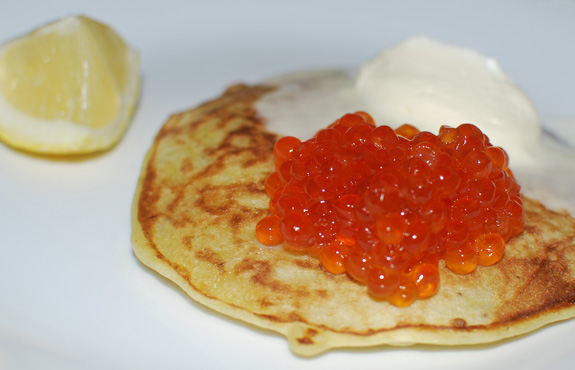There are literally hundreds of Russian pancake recipes. The Bolshaya Kniga Domashney Kukhni by Svetlana and Lidia Lagutina alone counts more than 70! These recipes distinguish themselves by the type of flour or starch used (wheat, buckwheat, rye, semolina, potato), the raising agents or aerators present in the batter (yeast, baking soda, beaten egg whites, yogurt), and their use (plain with toppings, stuffed, or stacked with filling to make a cake). The thickness is also of particular importance in the Russian taxonomy: blini are alway thin, whereas thick pancakes are called oladi.
Here are four of my recipes, that I make regularly:
- The original blini are similar to French crêpes, if only a bit thicker. This is the kind that you will be served 99% of the time in Russia. There are even cafés dedicated to them, the blinochnayas. They can be paired with anything you can think of: ground meat, cheese, smoked fish, fish roe, sour cream, jam, honey…
- The thick yeast-free blini would really be called oladi in Russian. These are very airy pancakes that can be prepared quickly thanks to the beaten egg whites. They go particularly well with strong flavors, like herring, salmon roe or eggplant caviar.
- The buckwheat blini are somewhere between the blini and oladi in thickness, with a very traditionnal batter. Try them with smoked or cured salmon (like my recent kippered and marinated recipes).
- The potato blini, too, should be called oladi because of their thickness. You can use them like the yeast-free blini.

Original blini
Yields 16 blini
12 oz flour
1/2 tsp baking soda
1/4 tsp powdered orange peel (optional)
3/4 tsp salt
2 tsp sugar
12 oz milk
5 eggs
12 oz water
2 oz butter, melted
- In the bowl of an electric mixer, mix the flour, baking soda, powdered orange peel, salt, sugar, milk and eggs with the paddle attachment on medium speed until smooth. Add the water and melted butter and mix again. Cover with plastic wrap and let rest for 30 minutes.

Yeast-free blini
Yields 20 blini
12 oz flour
3/4 tsp salt
1 tbsp baking soda
3 egg yolks
16 oz milk
3 oz butter, melted
4 oz yogurt
3 egg whites
- In the bowl of an electric mixer fit with the paddle attachment, mix the flour, salt and baking soda. Add the egg yolks and half of the milk, and beat over low speed until smooth. Add the melted butter and the rest of the milk, and beat again. Mix in the yogurt. Cover and let rest for 30 minutes.
- Whip the egg whites to soft peaks, and fold into the batter.

Buckwheat blini
Yields 16 blini
8 oz milk
2 tsp active dry yeast
3 oz buckwheat flour
3 oz white flour
1/2 tsp salt
2 egg yolks
7 oz crème fraiche
2 egg whites
- Mix the milk and yeast, and let rest for 10 minutes.
- Mix the buckwheat flour, white flour and salt. Mix in the egg yolks and the milk mixture. Cover with plastic wrap and let rest in a warm place for about 1 hour, until it has doubled in volume.
- Incorporate the crème fraiche. Beat the egg white to soft peaks, and fold into the batter.

Potato blini
Yields 16 blini
1 lb peeled Yukon Gold potatoes
2 oz flour
1 1/2 tsp baking powder
4 oz milk
1 egg
1 egg yolk
1/4 tsp salt
1/4 tsp ground black pepper
1 egg white
- Place the potatoes in a pot with cold salted water, bring to a boil, and cook until tender.
- Rice the potatoes, cover with plastic wrap, and let them cool.
- In a bowl, mix the flour, baking powder, milk, egg, egg yolk, salt and ground pepper. Add the riced potatoes and mix well. Let rest for 30 minutes.
- Whip the egg white to soft peaks and gently incorporate into the batter.
Cooking the pancakes
butter
pancake batter
- Heat a non-stick skillet over medium heat.
- Place a tiny piece of butter in the pan, and spread it with a paper towel. Ladle in a spoonful of batter. My blini are about 7″ diameter, and the oladi half of that. For the thin blini only, swirl the pan to spread the batter. Cook until golden brown, then flip with a spatula. Cook until the other side is golden brown, then reserve on a plate with a small piece of butter on top. Repeat until you run out of batter.
- For the potato blini only, place the fried pancakes in an oven-safe dish, cover with foil, and bake in a 350 F oven for an additional 10 minutes.
- Serve warm.







